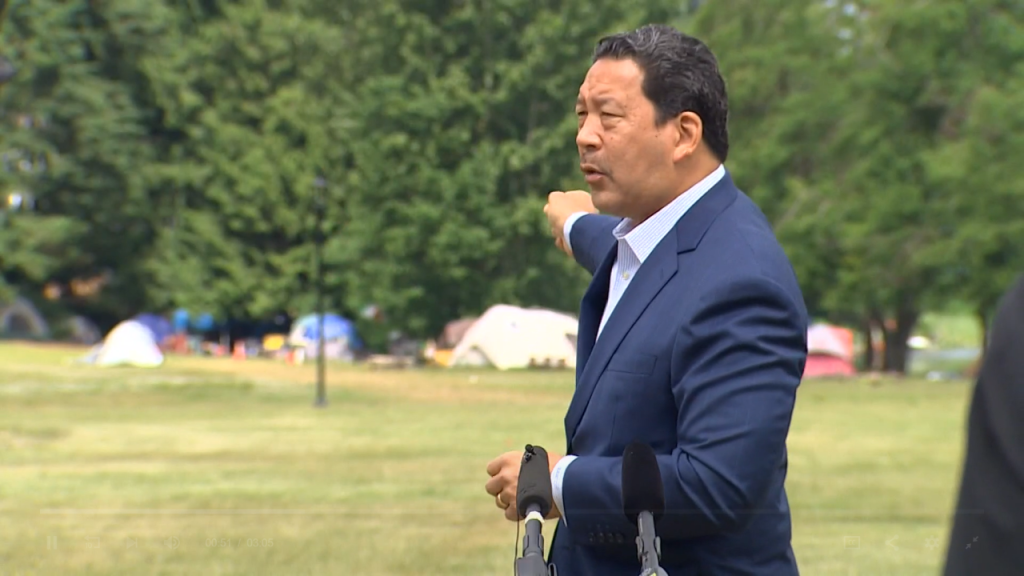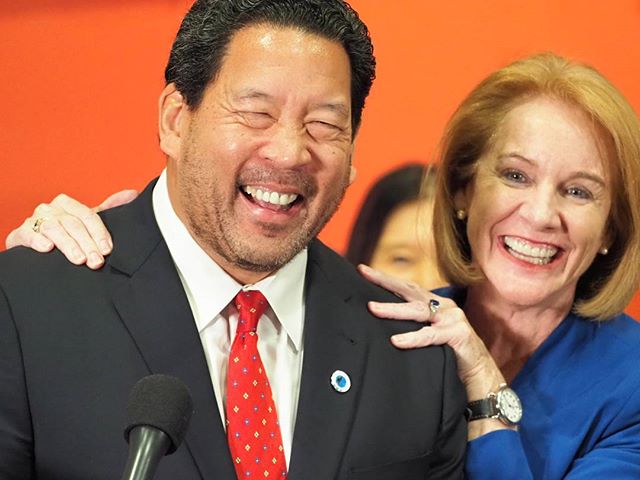
Council President Lorena González’s resounding loss to former Council President Bruce Harrell marks the third straight Seattle mayoral election in which the progressive fell to the corporate-friendly centrist. González conceded the race Thursday. To make matters worse, progressives also lost a Seattle City Council seat and the City Attorney’s office, barring a miraculous comeback. Councilmember Teresa Mosqueda did hold on to her seat easily — she’s up 18 points as of Friday — and progressives are on course for two pickups on the Seattle Port Commission, but overall 2021 was a setback for Seattle progressives.
Soul searching is underway in progressive circles, while some centrists are indulging in gloating, as can be expected.
Sandeep Kaushik, a consultant and lobbyist for Comcast and Lyft who advised Republican Ann Davison’s campaign, penned the magnum opus in this genre under the title “Bubble Trouble: How Seattle’s Radical Left Grew and (Predictably) Got Whupped.” The piece has self-congratulatory pomp, condescending advice, and clumsy wordplay in spades, but Kaushik’s central premise is worth considering. Is the left unmoored, overconfident, and out of touch? Do progressives need to retool to win?
Looking farther afield, Virginia Governor Terry McAuliffe’s loss to a Republican does have Democrats worried about a national shift to the right. But it’s not clear turning to moderates running in the corporate-friendly center lane is the fix, since Governor McAuliffe was the posterchild for this kind of candidate. Plus, across the country there’s no clear pattern of victory for corporate friendly moderates; progressives prevailed in some big races, such as Elizabeth Warren protégé Michelle Wu coasting to victory in Boston’s mayoral race on a Green New Deal platform. Cleveland elected Justin Bibb on a police accountability and affordable housing platform despite his opponent’s attempts to brand him as a Defund candidate.
In the specific example of Seattle’s off-year mayoral elections, losing two straight races by double digits appears to be proof of concept. But, on the other hand, in order to make good on his bold pledges, Harrell now has to clean up the mess he pointed to on the campaign trail. If Harrell can’t deliver and show his policy platform and governing strategy works, what has he really proven? That said, even if Harrell can’t meet campaign promises, until progressive mayoral candidates get better at articulating an alternative vision and holding centrists accountable to their promises, they may well keep losing in Seattle.

One might have hoped for Seattle voters to have learned this lesson from Mayor Durkan’s hapless administration, but the genius of centrist campaigning this cycle was to relentlessly refocus voter anger and disappointment on the Seattle City Council, which had been a project of many years for the centrist pundit class. In reality, Seattle has a strong mayor system and many of key failures of the past four years should be laid at Durkan’s feet and the centrist administration before her. But, perhaps the greatest gift Durkan ever gave to her establishment backers was knowing when to exit stage right.
Well-timed exits laid groundwork for centrist wave
Without Durkan running in the election as a sharp reminder of a four years of inaction, insularity, and shrouded secrecy, voters clearly funneled their dissatisfaction at City Council instead. None suffered more from this dynamic than Council President González, who apparently seemed to voters as the next best emblem of a wayward City government and lack of progress addressing homelessness once Durkan was removed from the equation.
Knowing when to make his quiet exit also served Bruce Harrell well. Harrell served 12 years on Seattle City Council and didn’t really leave much of a lasting mark — even on the central issues on which he staked his mayoral campaign like homelessness and police reform. This is despite having allied with centrist mayors to work with for eight of those years. However, bowing out rather than facing a tough challenge from Tammy Morales in 2019 ended up baptizing Harrell anew from his association as an ineffective councilmember to — somehow — a competent outsider. It’s amazing what a 22-month break will do.
Exiting stage right meant Harrell had time to rest, relax, and prep his campaign rather than take part in tough decisions during a grueling pandemic that was paired with big budget shortfalls, mass protests, police tear gassing whole neighborhoods and abandoning East Precinct, a coordinated coverup in which Mayor Durkan and several top police officials deleted their text messages in violation of public records law, and then Mayor Durkan firing whistleblowers in her public records office.
Would Harrell have stuck by the Seattle Police Department (SPD) as they bungled things and doubled down? Could he have averted austerity budgeting without passing the JumpStart Seattle tax that Mayor Durkan opposed but ultimately raided to patch her budget? Could he have signed JumpStart without earning the ire of corporate leaders? Would he have seen a middle way out of the infighting as he now promises to do as mayor? Could he get the Seattle Metropolitan Chamber of Commerce to drop their second legal challenge to JumpStart?
We’ll never really know how Harrell would have handled the last two years, a period Mayor Durkan has called the most challenging in the city’s history. Surprisingly, he didn’t seem to face many questions about how he would have handled key decisions differently. But now Harrell has four years to pick up the pieces and make good on campaign boasts. Whether Harrell can display policymaking skills as mayor that he didn’t really flash as councilmember remains to be seen. But that is the bet that Seattle voters have made.
Owning the issue of homelessness
The task for progressives is to break this pattern of centrist mayors playing them and their council majorities for fools and swiping credit for their key initiatives (like JumpStart) or obstructing them (pedestrianizing streets and equitable zoning reform) as they see fit and then turning around and blaming them for inaction and “divisiveness.” Progressive messaging in 2021 made some attempts at telling this story, but it failed to resonate and cut through the noise. The issue of homelessness dominated the election, and Harrell owned the issue.
González ran on a tax-the-rich platform, but what she’d invest the revenue on seemed to get lost in the shuffle. Supportive housing for homeless Seattleites certainly seemed to be in her plans and it’s a big part of what the JumpStart tax funds, but the vision didn’t seem concrete enough to inspire voters. The audacious promise from Harrell and the Compassion Seattle campaign to make 2,000 emergency housing units magically materialize in his first year with no new funding also helped wash out González’s message.
Now, unless Harrell is planning to pull a Durkan and retire rather than run for re-election, progressives at least are likely to have the opportunity to make the election about the incumbent mayor’s failure to meet his promises. Progressives need to get better at holding centrists accountable when they govern far from their campaign promises. Unless, Harrell manages to pull off a miracle and add 2,000 housing units in a year, he’s going to have answer for a failed pledge. Readers of The Urbanist may recall, Mayor Durkan promised 1,000 tiny homes in her first year, but built only 73 and still hasn’t made good on even half that in the proceeding years. Unfortunately, readers of most other publications didn’t hear much about that, and campaigns did not stress this issue enough, either.
The Compassion Seattle plan was a quick emergency shelter buildout on the cheap and then the clearing of encampments from parks as soon as possible. But clearing encampments without a viable plan to shelter homeless people and stabilize them in permanent housing is inherently a temporary fix akin to a game of whack-a-mole. It may provide temporary relief to the homeowners near the encampment site, but the encampments will form again elsewhere in absence of stable low-barrier housing to offer the chronically homeless. The emergency housing thrown together in one year is not going to be permanent housing or high-quality.
The pandemic drove the increase in encampments since the City and its providers had to ensure physical distancing at congregate shelters right as many people lost their jobs or suffered relapses or intensified addiction issues due to the stress, anxiety, and isolation of the pandemic. The Centers for Disease Control also gave guidance against sweeping homeless camps during a pandemic to lower transmission risk, but the Durkan administration has continued to conduct some sweeps (albeit at a lesser pace) anyway.
Perhaps, most of the Seattle electorate didn’t really want to hear nuance and explanations why it’s a tough problem to solve. They wanted assurances the problem would be fixed soon. Even if it turns out to be a lie, Bruce Harrell was willing to make that pledge.
Structural disadvantages
Overpromising on the salient issue of the election can be a potent campaign tactic, even if it leads to tougher reelection four years down the road. But Harrell and the centrists also had other structural advantages on their side. Centrists can count on a significant fundraising advantage and favorable media coverage since many of the mainstream media sources in Seattle are conservative owned — from the Blethen-owned The Seattle Times to the Sinclair-owned KOMO. It’s not just fundraising and media bias, the centrist political machine is also more professionalized and better organized.
Harrell’s message was carefully calibrated to appeal to the likeliest off-year voters: Boomers and homeowners. The Urbanist has predicted the increase in Seattle’s tenant population would eventually swing the city’s politics, especially on issues of housing and wealth inequality. But when turnout is 50% and the half of the city that sat this election out is overwhelmingly tenants and younger people, then our politics are not going to reflect Seattle’s demographics, which recently became majority-renter for the first time in several generations.
Switching to even-year mayoral elections likely would not have saved González given her decisive defeat, but it would have given tenants a bigger voice and more of a chance to influence the debate. Outside of his 2,000 emergency housing pledge, Harrell never really articulated a clear policy on housing and criticized González in debates for calling for apartment ban repeals, and he got away with it. This could have big implications for the next big zoning debate that will come with the 2024 Comprehensive Plan update. Is Seattle under Mayor Harrell going to try to grow more equitably and promote affordable housing throughout the city or shrug and call the status quo good enough?
The centrist political machine
The business community, and the consulting and public relations apparatus around them, are always plotting the next campaign and seeding it with polling and messaging that feeds into poll-tested messages and brands their opposition before a candidate has even arrived. Much of this work happens via the Seattle Metropolitan Chamber of Commerce and the Downtown Seattle Association, which released their polling in 2020, telegraphing their key issues and how they were likely to frame them. They carefully select a candidate ready to run their plan to the fullest and and rarely fail to get them through the primary given the consensus that has been reached ahead of time. Harrell was likely more progressive than some business leaders wanted, but their side didn’t splinter and backed him anyway, seeing that his pedigree growing up in the Central District, being a football star at the University of Washington, and a distinguished lawyer would play well.
The centrist machine playbook also planned negative messaging early with thorough opposition research that catalogued negative tweets and controversial statements. They then started amplifying them early through intermediaries that mostly insulated the candidates themselves from being being seen as launching the attacks. With the hits on the opponents delivered early and often by their allies, the final campaign messages centrists delivered in crunch time were largely positive and hopeful. Centrist candidates presented themselves as pragmatic “get things done” unifiers to cut through the gridlock and divisiveness. This is the third time that centrists have successfully used this formula while paying little penalty for not delivering on an end to divisiveness and gridlock on key issues in the city.
The centrist machine also learns from their mistakes. Since telecommunications executive Joe Mallahan’s failed mayoral bid in 2009, centrists haven’t run a straight White guy or a corporate executive for mayor. Instead, they select someone very ready to carry the corporate agenda, but who is also ready to appeal to a demographic outside their base. Because Harrell is of Black and Japanese descent, criticisms related to race and equity didn’t stick to him, and he turned the tables when Gonzalez inadvisably ran an ad with a White woman accusing him of siding with sexual abusers. Having a person of color this cycle, a lesbian before that, and a gay man on the ticket before that, allowed centrists to offer some semblance of social progress even if their economic platform in practice has boiled down to the rich get richer and the poor get scraps. And, to be clear, the centrists have championed a smattering of progressive programs, like Harrell’s “Health Care for All” idea and Durkan’s universal pre-K education, to curry favor with voters, even if the details are vague and campaign commitments are squishy.
One thing centrists didn’t do following their loss in 2009, however, was reconcile and help progressives implement their agenda. The centrist machine also still controlled the Seattle City Council at the time, so they had their base — which included Harrell — stonewall Mayor Mike McGinn’s agenda and did everything they could to paint him as ineffective, divisive, and out of touch, rebranding him Mayor McSchwinn in the process. The labels stuck and McGinn lost narrowly to Murray in his 2013 reelection bid.

When the 2019 election blew up in their faces, centrists changed tactics. Amazon’s late million-dollar money bomb refocused the election around corporate excesses and juiced progressive turnout. Outside of Alex Pedersen, the Amazon/Chamber backed candidates were routed. In reaction, the Chamber announced it was going to take a step back and get out of the political action committee (PAC) game, putting its heavy-hitting Civic Alliance for Sound Economy (CASE) PAC on ice. Instead of being the funnel for corporate donations, those companies and business executives gave directly to PACs set up separately for each candidate.
The PAC backing Bruce Harrell still raised well over a million dollars, but it was harder to point to one villain without Amazon and the Chamber focusing attention on themselves. The biggest donor to Harrell’s PAC was George Petrie and his business partner John Goodman of Goodman Real Estate, a major Downtown landlord and prolific evicter. Petrie was also Trump’s biggest donor in Washington state, and González attempted to link Harrell to Trump, but it just didn’t resonate with swing voters like Amazon’s money bomb did in 2019. As The Stranger‘s Rich Smith put it, instead of Amazon, we got Amazon’s landlords giving in 2021. Additionally, Amazon did seem to be running a ton of TV ads about its $15 minimum wage, perhaps hoping to repair its public image after the 2019 debacle.
Progressive tent-building
To some extent this coalescing, planning, and course correction also happens on the left, but not nearly as systematically nor as grounded in political science and a strategy for winning the general election — not just the primary. For example, early polling provided warning signs that Council President González was not going to be a strong candidate this cycle, despite a strong progressive résumé and winning her last two citywide races decisively — albeit against middling opponents. Polling was clear: homelessness was going to be the top issue and the vast majority of voters thought the city was on the wrong track. It’s tough to be the incumbent in such an environment.
This is what ultimately pushed The Urbanist Elections Committee (of which I’m a member) to endorse Colleen Echohawk in the primary (before switching to González in the general). With her long stint running Chief Seattle Club, a housing and homelessness service provider geared toward urban Indigenous people, Echohawk could run as an expert and own the issue of homelessness while still running as an outsider. Nearly every other progressive group that weighed in went with González, including the pivotal endorsement from The Stranger, arguing Echohawk wasn’t sufficiently progressive. Echohawk finished a distant third in the primary with 10% of the vote.
Asymmetrical political warfare
It’s an asymmetrical contest right now between centrists and progressives in Seattle. The centrist side is well-funded, never stops campaigning, follows political science to hone their message and campaign plan, and exerts a great deal of message discipline. The progressive side doesn’t start campaigning and coalescing until the election year and finds itself woefully behind the opposition in orchestrating their plan, as expertly laid out by the panel on Crystal Fincher’s Hacks & Wonks post-election roundtable below.
The confluence of factors in 2021 played right into the centrist machine and their simple, but effective, campaign strategy. Having González, Nicole Thomas-Kennedy, and Nikkita Oliver on the same ticket seemed to help centrist messaging that ‘radical activists have gone far’ hit home. With surgical precision, the centrist machine branded González as the status quo incumbent and Thomas-Kennedy and Oliver as too radical. It all blended into a ‘more of the same’ radical hodgepodge that turned off voters right as the centrist machine planned. Never mind that Mayor Durkan is the incumbent and Bruce Harrell’s platform is remarkably similar. That didn’t matter when the structural disadvantages were so steep and progressive messaging was so scattered compared to the opposition.
In a Citizens United ‘corporation are people, my friends‘ world, progressives are unlikely to hold the edge on fundraising, so they really have to get the messaging right. There’s little room for error. Occasionally, a megarich progressive donor comes along like Nick Hanauer and erases some of the independent expenditure deficit, but in Seattle’s case, his money has always flowed to Jessyn Farrell, the vice president of his think-tank, and then dried up after the primary ends and she doesn’t make it through. That leaves unions as the only progressive funder to counteract the copious corporate and real estate campaign spending, and they struggle to keep pace in citywide races. And this year unions spent so much winning the primary for González (dried cherries aren’t cheap) that they were depleted for the general election.
Progressives can still win in Seattle on bold platforms, and we can see from races around the region that progressives are still gaining ground in the suburbs with cities like Burien, SeaTac, Everett, Bothell, and Kenmore swinging toward progressives. Republican King County Councilmember Kathy Lambert also lost to Democrat Sarah Perry in the 3rd District, which spans from Redmond and Sammamish to the east. This doesn’t bode well for the narrative of a major rightward shift in Seattle metropolitan races going forward. A few whiffs in Seattle doesn’t make a long-term regional trend. But progressives are going to have to run smarter campaigns to win citywide races in Seattle.
Progressives need to adapt to the specific conditions each election cycle presents to put forward the best campaign, lead with progressive values, but avoid leading with their chins. A boxer who leads with their chin tends to get knocked out, as we found out this cycle. As Bibb showed in Cleveland, progressives can win on police accountability in mayoral races, but they would be wise to have a knockdown case presented carefully and avoiding terms that turn off swing voters, even if the concept is still there in less inflammatory terms.
Wu’s inspiring campaign in Boston offers some hints for progressives. She centered her messaging around a clear Green New Deal platform and also championed rent stabilization as a tangible, immediately-felt improvement to the lives of stuggling tenants. That’s a demographic that didn’t turn out enough in Seattle, but carefully-calibrated rent control and a Green New Deal could cut through the malaise and incite younger voters to turn out in much higher numbers.
Doug Trumm is publisher of The Urbanist. An Urbanist writer since 2015, he dreams of pedestrian streets, bus lanes, and a mass-timber building spree to end our housing crisis. He graduated from the Evans School of Public Policy and Governance at the University of Washington in 2019. He lives in Seattle's Fremont neighborhood and loves to explore the city by foot and by bike.



